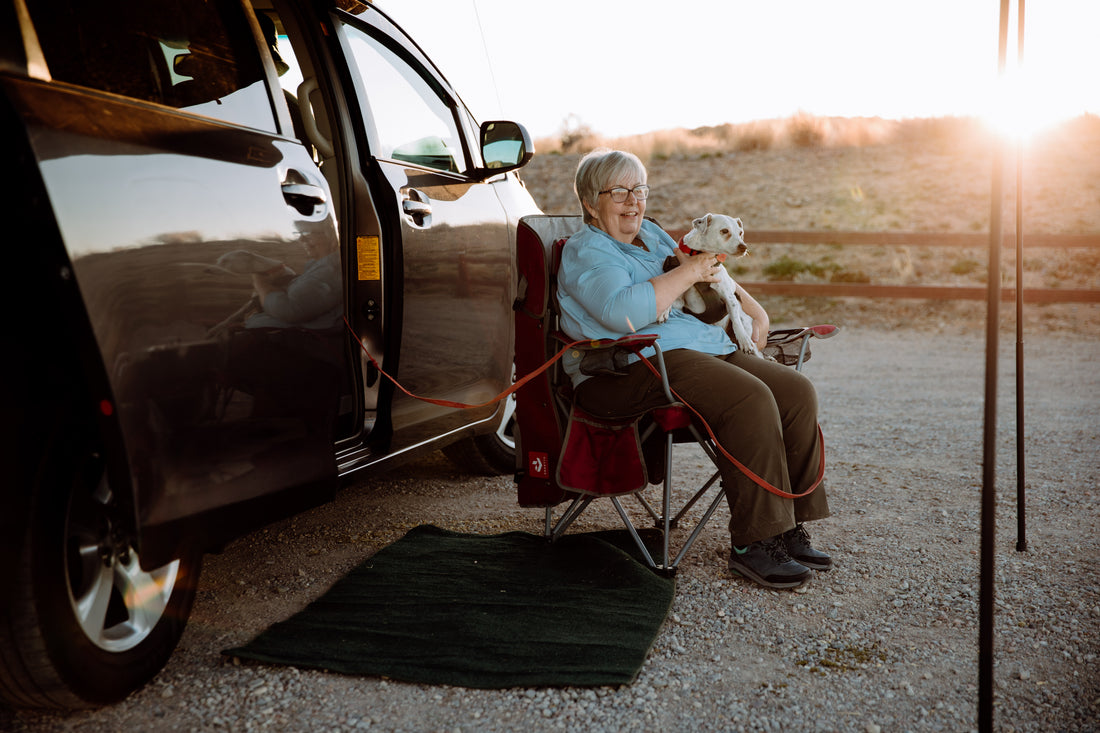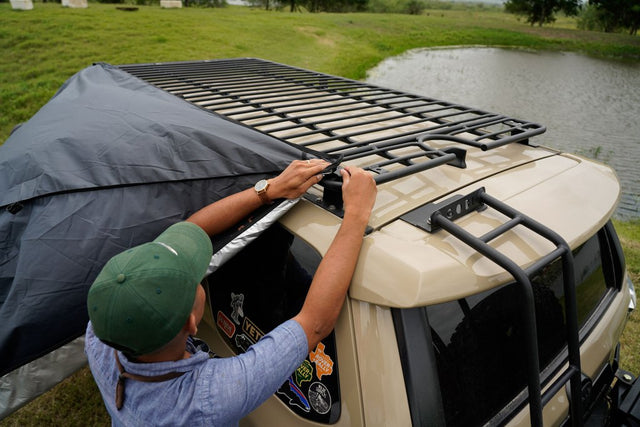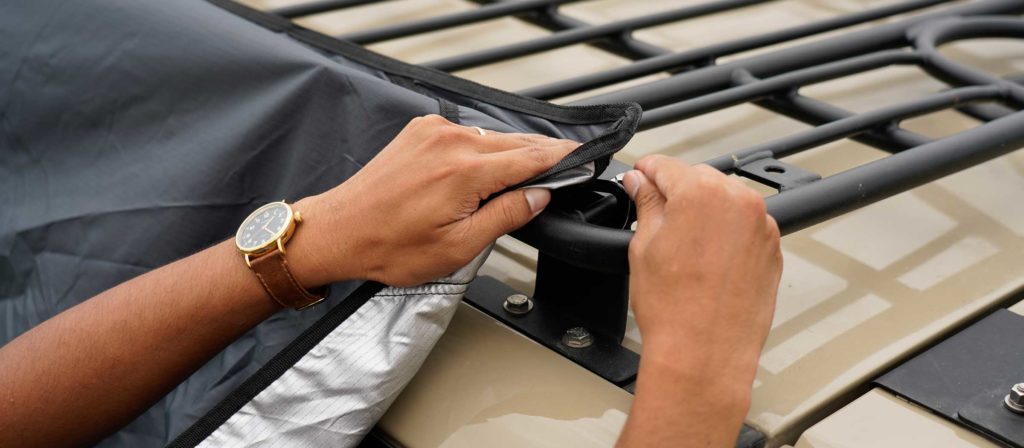
"I’m very comfortable in solitude. There’s just something about getting out on the road where you want to see what’s around the next bend."
—Kathi Foy
Filmmaker’s Notes
The red-ochre cliffs of Palo Duro Canyon stretched out in front of us to the horizon as the daylight faded, and we knew the night would be cold, just the right weather for the biggest bonfire we could muster at our campsite. We were just settling in beside the blazing campfire when we saw the headlights of the game warden’s truck approaching and a couple of uniformed rangers got out to let us know that, for the second night in a row, we were in trouble with the law — there was a current burn ban that we hadn’t known about, and the fire had to be put out. As for the rangers, they turned out to be a couple of nice guys, and sat with us for a while as we told them about who we were and where we were headed.
We met Kathi in Santa Fe, after that night in the canyon, and as we listened to her tell the story of her life, we began to recognize how impactful this project would come to be for the both of us.

Kathi’s van is affectionately named “Vamos”, and her first big trip was in the summer of 2018, when she was a campground host at Santa Fe National Park. She and her husband Carl had sold their house and moved the year before that trip, after Carl was diagnosed with Alzheimer’s — together, they live on Social Security, and she knew they wouldn’t have the monthly income after the expenses of memory care to cover the cost of living and renting an apartment. After a visit that same year to Rubber Tramp Rendezvous, a gathering of nomads, van-lifers, and those seeking an alternative way of living, the idea was birthed to split time between living at her daughter’s home in Albuquerque, and spending the rest of her time traveling in “Vamos” with her dog Blanco as company.
With Henry tailing Vamos in the MoonVan, Richard rode along in the passenger seat with Kathi while filming and talked with her about the experiences that ultimately attracted her to a life on the road.



Read the Interview
Richard:
So how often do you go on solo adventures?
Kathi:
Well, before COVID I’ve tried to get out at least once a month. My first big trip really was in the summer of 2018 when I was a campground host of the Santa Fe National Forest, up at a place called Rio de Las Vacas. It was close enough that I could come home, so I’d go up for five days and come home for two to do my laundry, take a shower, and check in on Carl. So that worked out nicely until the fire season started and they closed the National Forest. I had (my grandson) Rowan with me up there so he and I and Blanco and Vamos were the only ones up at the campsite. We had a little pond that we went swimming in, and we had a great time.
Richard:
What was the initial motivation for getting the van?
Kathi:
2017 was our big year of transition, where we sold our house and tried to figure out everything that was going on. I knew that when Carl goes to memory care, I would have to figure out what to do because we’re retired and live on Social Security. His social security check would go for his room and board, but I wouldn’t have enough to afford our apartment. So that’s when I started looking into it. I said, “Oh, I could live in my van, and I could travel.”
I started watching YouTube, and I went to the Rubber Tramp Rendezvous that Bob Wells runs in January of 2018. I started piecing things together over the last, what, three, four years. I’ve slowly gotten everything together, just saving money each month — now the van feels very livable.
Richard:
So really you just needed a place to live?
Kathi:
Yeah, that I could live on with my retirement. My daughter has some property in the South valley of Albuquerque, so that’s going to be my home base, and I can park Vamos there and live out of Vamos. She’s thinking of building a little “casita” there for me, for whenever I get old and decrepit.
But I have always wanted to travel, you know, so I know I can’t afford it any other way than to jump in the van and go somewhere. That was a big motivator too — not just a place to live, but a way to travel. I’ve lived in so many different places, I have friends all over the United States, I’d love to go across Canada, down to Mexico…a lot of people ship their vans across the ocean and do Europe that way.
I’ve slowly gotten everything together, just saving money each month — now the van feels very livable.
Richard:
What’s important to you about traveling?
Kathi:
I’m just endlessly curious. And just the thought of sitting and watching TV, or, you know, just sitting in my retirement doesn’t sound like that much fun.
I belong to this group for van dwellers or vehicle dwellers called Harvest Hosts, and there are different places that you can go and park, like vineyards or museums or farms all around the United States that will invite people who are vehicle dwellers to stay there. And plus, there’s a lot of Bureau of Land Management land and state parks, we have 35 wonderful state parks in New Mexico.
I’m just endlessly curious. And just the thought of sitting and watching TV, or, you know, just sitting in my retirement doesn’t sound like that much fun.
Richard:
Do you like meeting other people on the road?
Kathi:
Yeah, yeah, yeah, as a campground host, I go around and talk to people. With Blanco, when we’re at a campground, we always take a stretch and walk around and say hi, and visit, and that kind of stuff. It’s just travelers meeting travelers on the road. And it’s a nice anonymous kind of thing, you know, because you’re living in the present so much — I really find that that’s very spiritually nourishing for me, to focus on living in the now. And that’s a helpful way to do that… you don’t have to know where they’ve been or where they’re going, you’re just spending that little bit of time with them, talking about where you’ve been on the road and what you’ve been up to, and sitting around the campfire. It’s just camaraderie.
When I went to the RTR, I went to Crystal’s campsite. She’s someone that I met online, she has a Youtube channel called Nomad For Less, where she focuses on traveling with tight budgets and older rigs. She invited me to come hang out at her camp, and I met a lot of people there, and ended up traveling with one of the people that I met at that camp. I went up to Colorado and did the hot springs, just going from hot spring place to hot spring place, “taking the waters” as they say in Jane Austen’s books. It’s a way of self-care and relaxation and something fun to do.
You don’t have to know where they’ve been or where they’re going, you’re just spending that little bit of time with them.. It’s just camaraderie.
Richard:
What is it about this lifestyle that draws you in?
Kathi:
Right here, the blue and the brown, just the open road. It just fuels my spirit, there’s something very calming and uplifting about it. I like the solitude and I never really feel lonely or anything. I’m very comfortable in solitude. There’s just something about getting out on the road where you want to see what’s around the next bend.
As a hospice chaplain, my office was in my car. I visited people in their homes, and I could get out in the weather and see what’s going on. You know, I wasn’t stuck in a cubicle somewhere, so I guess I was spoiled by that. That’s why the thought of living in a van and traveling isn’t intimidating at all.
Twenty-five years of hospice work prepared me for never knowing what life is going to offer. With Carl, the hardest thing for me to figure out was not to say “remember when”, because he doesn’t have any of those memories. I tease and say I can make up anything about our life. He’s really helped me with living in the now for sure. That’s where he lives all the time.
Twenty-five years of hospice work prepared me for never knowing what life is going to offer.
After the drive, Kathi set up the MoonShade and showed us around Vamos, her van, before going out for a walk together where the conversation continued.
Henry:
Earlier you were talking about being aware of your own emotions — do you find that people in the RTR community are more self-aware than your average human?
Kathi:
No, I think they’re just like any other humans. I think this setting brings people together and encourages community, so I think people are more open in that sense, that they’ll probably talk to somebody that they wouldn’t talk to otherwise.
Henry:
You mentioned being a chaplain in the past and having some connection to sacred traditions. When you’re alone, whether in the van or in a space like this in nature, do you feel connected to something, or meditative?
Kathi:
I was talking to Richard a little bit about that on our walk, just being totally present and letting go of things that are maybe a little heavier.
Some people get a daily prayer, I get a daily poem from the Paris Review. That’s a wonderful way to kind of start my day, you know, a daily poem. Everyone has their way of connecting into something. I love to learn about new ways. I was certified by the board of Chaplains by the Association of Professional Chaplains, and had to keep up continuing education units. And so I would always go to something like a Sufi retreat, or go to a talk about Buddhism and death. That feeds me and has fed me and, you know, there are things that I can go back to, things that I know will help me.
One of the things that I did when we moved was get rid of all my books. When I was in Chicago, I think I had a library of about 3000 books, and we had just built a building in Glenview at Midwest Palliative and Hospice Care Center, so I donated all my books to them. I figured, well, I could find them in the library. I used to be holding on to them, but I’ve let all that go. I’ve just let it go. I used to love beautiful pens, you know, like Mont Blanc, but then I lose them. And I’d be like, oh my gosh, I lost that pen that was so expensive, and so perfect, and the ink was just flowing just right…
When I lived in New York, I did my training in New York for the New York Society of Ethical Culture, and one day I came into work and I left my umbrella on the bus. Our receptionist Priscilla said “Welcome to New York. What we do in New York is we trade umbrellas.” Then she reached behind her and someone else had left an umbrella. It happened to be a New Yorker umbrella, and that was great because I love the New Yorker. So I had that one for a while until I passed it on to someone else. It’s that kind of thing that has helped me grow into a minimalist lifestyle.
I used to be holding on to them, but I’ve let all that go. I’ve just let it go.
As we said our goodbyes and got back into the van, we were both struck by how much of a gift it had been to have met Kathi. Like with Paul, the first person we’d met on the road who we affectionately nicknamed “the Prophet”, we took to calling Kathi “the Saint”, and we talked about the inspiration that we’d taken from the visit all the way from Santa Fe to Arizona, where we’d planned a meeting with Dan, a former-actor-turned-van-lifer, with an interesting story of his own.





